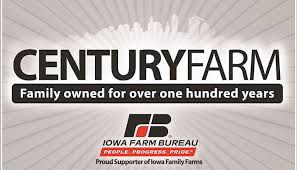Category: Farm
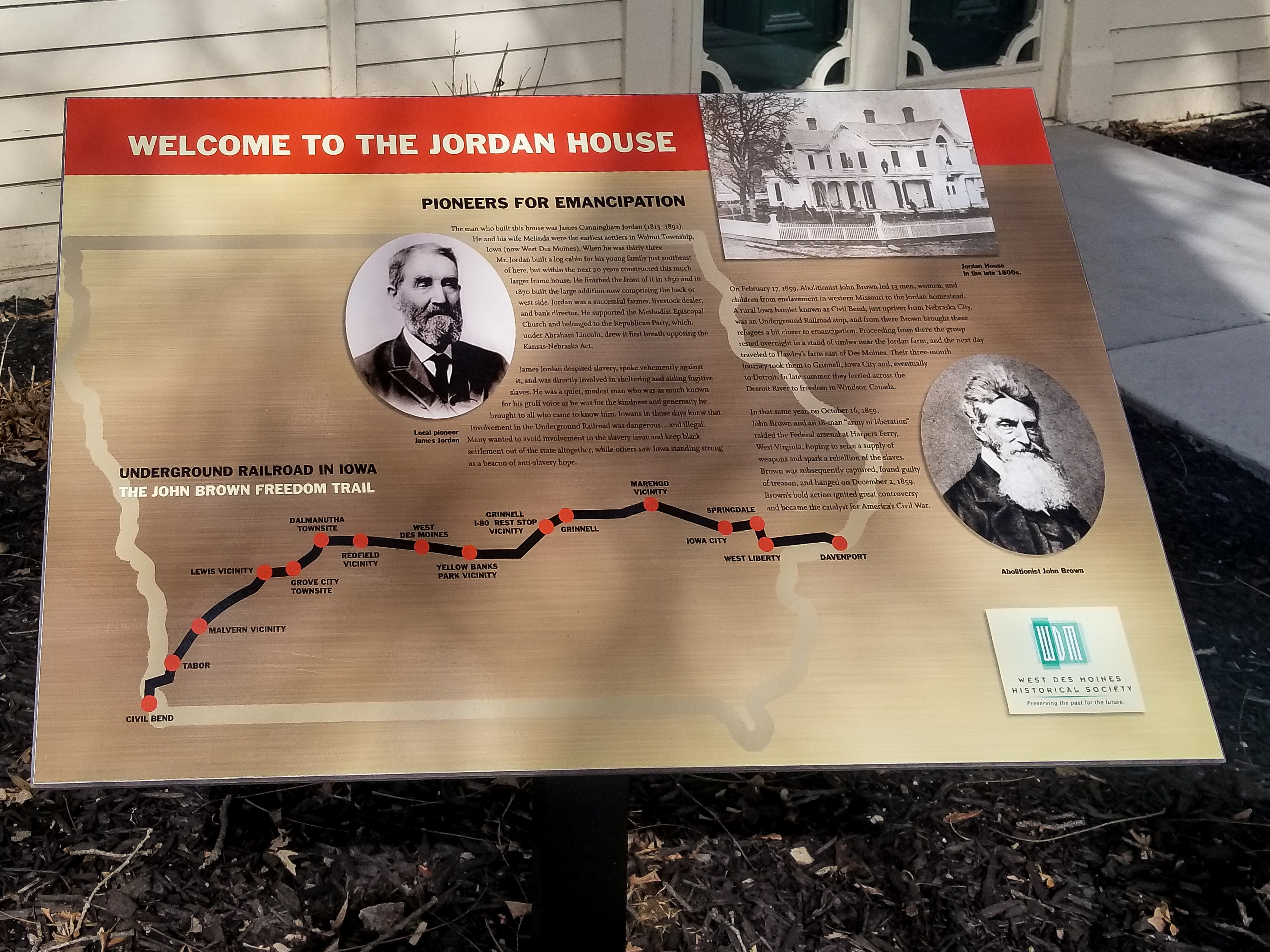
Meet Iowa Farmer James Jordan, Underground Railroad Conductor
Some call them upstanders. Others call them allies. These courageous people are the ones who stand up to help those being oppressed, even at the risk of their own safety. In frontier Iowa, James Jordan fearlessly helped Freedom Seekers gain safe passage on the Underground Railroad route that passed near his farm in the area that would become West Des Moines.
The Underground Railroad ran across the southern and central regions of Iowa, a state where slave ownership was never legal. This impacted pioneer farmer J Jordan (1813-1891) and his wife, Melinda, some of the earliest settlers in Polk County’s Walnut Township. The land they once owned includes the stately Jordan House, which is located along Fuller Road in West Des Moines. The Jordan’s farm harbored fugitive slaves during the tense days leading up to America’s Civil War. Such daring deeds, however, weren’t always part of the Jordan family’s history.
Jordan was born in in 1813 in what is now West Virginia, in a community where slavery was ingrained in society and culture. Jordan, a cattle farmer, was expected to assist family members and neighbors in their hunt for escaped slaves. Jordan’s branch of the family, however, was influenced by a religious movement called “The Great Awakening” that was sweeping the country and opposed slavery. These experiences developed Jordan’s abolitionist beliefs and zeal, especially as he moved westward.
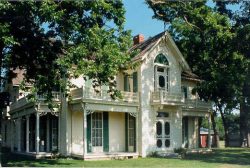
Jordan House, West Des Moines
Building a new life in central Iowa
As treaties were signed between the U.S. government and the Indian tribes that agreed to move out of the Iowa territory by the mid-1840s, pioneers like Jordan were ready to move in. After Jordan settled in the Walnut Township area of Polk County, he chose a beautiful location with ancient oak, walnut and hickory trees on land gently sloping to the Raccoon River. Jordan’s first shelter was a lean-to tent, which he replaced in 1848 with a log cabin.
In 1850, Jordan and his wife, Melinda, began work on the first phase of a new frame house. The family, which at that time included six children, lived for a time in the basement, which included a small kitchen and a bedroom/sitting room.
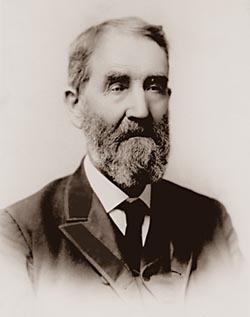
James Jordan
Aiding the Meskwaki
Jordan became a successful farmer, livestock dealer and bank director. Though Jordan’s dream was to develop and manage a financially successful livestock business, he remained deeply committed to helping others achieve their dreams, as well. He supported the Methodist Episcopal Church and belonged to the new Republican Party, which included many members who opposed the Kansas-Nebraska Act that Congress passed in 1854.
The Kansas-Nebraska Act allowed people in the territories of Kansas and Nebraska to decide for themselves whether or not to allow slavery within their borders. The Act repealed the Missouri Compromise of 1820, which prohibited slavery north of latitude 36°30´. The Kansas-Nebraska Act infuriated many in the North, who considered the Missouri Compromise to be a long-standing, binding agreement. There was strong support for the Kansas-Nebraska Act, however, in the pro-slavery South.
Pro-slavery and anti-slavery supporters rushed in to settle Kansas and impact the outcome of the first election held there after the law went into effect. Violence soon erupted, with the anti-slavery forces led by the radical abolitionist John Brown. The territory earned the nickname “bleeding Kansas” as the death toll rose.
Back in Iowa, many citizens wanted to avoid involvement in the slavery issue and keep black settlement out of the state altogether, while others saw Iowa standing strong as a beacon of anti-slavery hope. When Jordan was elected to the Iowa Senate in the mid-1850s, he was able to make a difference Sen. Jordan and his colleagues in the Iowa State Legislature helped the Meskwaki Indians achieve their dream of regaining the land they had lost in Iowa.
Speaking out against slavery
While Jordan was described as a quiet, modest man who was widely-known for the kindness and generosity he showed to all who came to know him, he despised slavery and spoke out vehemently against it. Jordan was actively engaged in the abolitionist movement locally, becoming the “chief conductor” of the Underground Railroad in Polk County. Jordan knew that involvement in the Underground Railroad was dangerous and illegal. Nevertheless, he became directly involved in sheltering and aiding fugitive slaves from his Walnut Township farm.
At the state level, Jordan promoted the anti-slavery Republican Party, and on the national level he befriended the radical abolitionist John Brown. Brown stayed at the Jordan House at least twice, the last time in 1859 when he was leading a group of 12 slaves he had recently liberated in Missouri to freedom in Canada.
On February 17, 1859, Brown led 13 men, women and children who had been enslaved in western Missouri to the Jordan homestead. The small group had begun their journey at a rural Iowa hamlet known as Civil Bend, an Underground Railroad stop just upriver from Nebraska City, Nebraska. From there, Brown brought the refugees a bit closer to emancipation. As they neared central Iowa, the group rested in a stand of timber near the Jordan farm.
(While people on the Underground Railroad stopped at the Jordan family’s property, they most likely never set foot in the actual home. Jordan was one of the largest land owners in the state, plus there were barns and outbuildings on his property, so it didn’t make much sense for freedom seekers to hide in the basement of the Jordan family’s home, according to the West Des Moines Historical Society in a 2018 interview with Des Moines TV station WHO Channel 13.)
After leaving the Jordan farm, the group of freedom seekers traveled the next day to a place called Hawley’s farm east of Des Moines. Their three-month journey took to them to Grinnell, Iowa City and eventually to Detroit, Michigan. In the late summer of 1859, the group ferried across the Detroit River to freedom in Windsor, Canada.
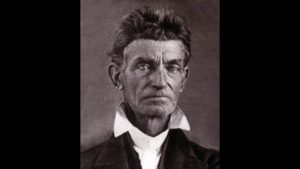
John Brown
Just a few months later, on October 16, 1859, John Brown and an 18-man “army of liberation” raided the federal arsenal at Harpers Ferry, West Virginia, hoping to seize a supply of weapons and spark a rebellion of slaves. Brown was subsequently captured, found guilty of treason, and hanged on December 2, 1859.
It’s interesting to note that Brown’s connections to James Jordan weren’t his only ties to rural Iowa settlers. One line of the Underground Railroad crossed the Raccoon River in southern Dallas County. Fugitive slaves in the 1850s sometimes traveled this route to the “Quaker Divide” northeast of Dexter. Many local members of the Society of Friends (Quakers) supported anti-slavery efforts.
Some residents, like Harmon Cook, were conductors on the Underground Railroad. When Brown was in the Dexter-Redfield area before his 1859 raid on Harper’s Ferry, he admonished Cook after the conductor almost got caught going to Des Moines with fugitive slaves. “Young man, never do so rash a thing as to talk and laugh out loud on the way.”
While no one knows for sure how many slaves reached freedom on the Underground Railroad, historians estimate that 1,000 slaves per year made the attempt. Most who tried did not have the benefit of someone like John Brown or Harriet Tubman to guide them along the journey and were not successful.
Seeking the north star of freedom
Jordan’s role in the Underground Railroad has been honored for generations. “The History of Polk County,” published in 1880, stated that “Jordan has been a life-long enemy of slavery; his devotion to the political life as a staunch and stalwart Republican is the outgrowth of deep-seated conviction; it is among the pleasant things to remember, that under his protecting roof John Brown and his associates, with more than a score of recently liberated slaves, have offered their prayers and sung their first jubilee hymns on their way to Canada….”
Jordan passed away in 1891, but his story lives on. Today, the Jordan House, a stately Victorian home of Italianate Gothic design, is one of the oldest structures in Polk Country and is one of the few locations in Iowa where visitors can tour the home of an Underground Railroad conductor. The home is listed on the National Register of Historic Places and is part of the National Underground Railroad Network to Freedom Program.
Perhaps Jordan’s legacy was best summarized by Jordan’s pastor, who eulogized him by stating, “In the days of slavery this great heart reached out and helped the oppressed, seeking the north star of freedom.”
Click here to learn more if you’d like to plan a visit the Jordan House in West Des Moines.
Want more?
This story is an excerpt from my book Iowa Agriculture: A History of Farming, Family and Food. Click here to learn more and order a signed copy here.
I invite you to read more of my blog posts if you value intriguing Iowa stories and history, along with Iowa food, agriculture updates, recipes and tips to make you a better communicator.
If you’re hungry for more stories of Iowa history, check out my top-selling “Culinary History of Iowa: Sweet Corn, Pork Tenderloins, Maid-Rites and More” book from The History Press. Also take a look at my other books, including “Iowa Agriculture: A History of Farming, Family and Food” from The History Press, “Dallas County” and “Calhoun County” book from Arcadia Publishing. All are filled with vintage photos and compelling stories that showcase the history of small-town and rural Iowa. Click here to order your signed copies today! Iowa postcards are available in my online store, too.
If you like what you see and want to be notified when I post new stories, be sure to click on the “subscribe to blog updates/newsletter” button at the top of this page, or click here. Feel free to share this with friends and colleagues who might be interested, too.
Also, if you or someone you know could use my writing services (I’m not only Iowa’s storyteller, but a professionally-trained journalist with 20 years of experience), let’s talk. I work with businesses and organizations within Iowa and across the country to unleash the power of great storytelling to define their brand and connect with their audience through clear, compelling blog posts, articles, news releases, feature stories, newsletter articles, social media, video scripts, and photography. Learn more at www.darcymaulsby.com, or e-mail me at yettergirl@yahoo.com.
Let’s stay in touch. I’m at darcy@darcymaulsby.com, and yettergirl@yahoo.com.
Talk to you soon!
Darcy
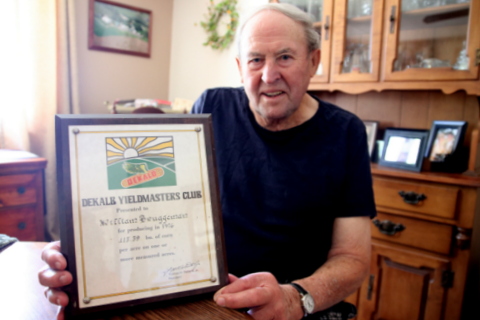
Memories of Carroll County, Iowa, Century Farm Endure
Among the most remarkable parts of rural Iowa are the thousands of families who have owned the same land for 100 years. I’ve had the chance to interview hundreds of Iowa families who own Century Farms. Some of these folks, like Bill Bruggeman, share the kinds of stories you never forget.
After Bill passed away this week (read his touching obituary here), I felt that sharing his story would be a fitting tribute to a dedicated, kind, hard-working Iowa farmer I respect greatly Here’s his story, which I wrote in 2017 for Farm News:
While all the buildings that once graced the Bruggeman family’s Carroll County Century Farm between Lidderdale and Lake City are gone, the memories live on.
“The times keep changing,” said Bill Bruggeman, 85, who lives with his wife, Doris, on a farm a few miles northeast of his family’s Sheridan Township Century Farm. “This spring I saw a farmer on RFD TV who could plant 2,500 acres a day. This country is going big.”
It’s a big switch from the 120-acre Carroll County farm that Bruggeman’s grandfather, John Bruggeman, purchased in 1903. John and his wife, Emma, had farmed near Johnson, Nebraska, before deciding their farming prospects were brighter back in Iowa.
While Bruggeman didn’t grow up on the Century Farm where his grandparents lived, he has fond memories of the farmstead, which once boasted a large farmhouse and barn. “When I was a little kid I’d go across the fields on Saturday mornings to get Grandma Emma’s fresh-baked cinnamon rolls,” he recalled.
Good food was perk of farm life, which was often filled with long days of hard work and few luxuries. “We didn’t get electricity on the farm until the 1940s and didn’t get running water until the 1950s,” Bruggeman said.
Horsepower sometimes came from the family’s Farmall tractor, but it also came in the form of May and Babe. “I loved that team,” said Bruggeman, whose family used the horses to plant corn, pull the manure spreader and haul hay. “They didn’t run away.”
Those were the days when 12 neighborhood families worked together in a threshing ring, a tradition that lasted until the mid-1950s. While Bruggeman’s father, Carl, and the other men worked in the field, Bruggeman’s mother, Marie, prepared fried chicken, roast beef, mashed potatoes, fruit pies, cream pies and more to serve the hungry men at noon.
“Around 5 p.m. you’d haul the last load of the day,” said Bruggeman, who noted that the wives provided the threshing crew with snacks around 3 p.m. “The men were usually served supper, too.”
The day’s work wasn’t done, however, since each farmer had chores to do at home. “Back then, many farms had about 20 beef cows, some dairy cows and about 10 sows,” Bruggeman said.
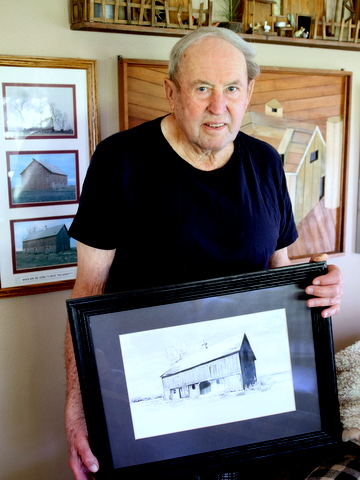
While the demands of farm work limited trips to town, there was fun to be had when it to was time to buy groceries. Bruggeman enjoyed the outdoor movies shown in Lidderdale in the summer months, back when the town had three grocery stories and about as many gas stations. “Dad would give me a nickel so I could get a pop or popcorn,” said Bruggeman, who recalled how cars were lined up on both sides of the town’s busy business district.
Money was hard to come by in those days, and crop yields were nowhere close to what farmers produce today. “When I was a kid, 60 bushels per acre of corn was a really good yield,” said Bill Bruggeman, who started farming full-time in 1955 after completing his military service. As improved corn hybrids become available, Bruggeman won the DEKALB Yieldmasters Club award in 1976 for producing 113.39 bushels of corn per acre.
While much has changed in agriculture since the Bruggemans were raising their four children (including Sheila, Brenda, Cathy and Brett) on the farm, the family is proud to honor the legacy of their Century Farm, which is now owned by Brett Bruggeman.
“It’s wonderful to have a Century Farm,” said Bruggeman, who retired from farming three years ago. “We’re lucky to have one.”
Bruggeman Carroll County Century Farm
• Established: 1903
• Township: Sheridan
• Acres: 120
• Century Farm Award given in 2016
• 4th generation farm
Want more?
Thanks for stopping by. I invite you to read more of my blog posts if you value intriguing Iowa stories and history, along with Iowa food, agriculture updates, recipes and tips to make you a better
If you’re hungry for more stories of Iowa history, check out my top-selling “Culinary History of Iowa: Sweet Corn, Pork Tenderloins, Maid-Rites and More” book from The History Press. Also take a look at my latest book, “Dallas County,” and my “Calhoun County” book from Arcadia Publishing. Both are filled with vintage photos and compelling stories that showcase he history of small-town and rural Iowa. Order your signed copies today! Iowa postcards are available in my online store, too.
If you like what you see and want to be notified when I post new stories, be sure to click on the “subscribe to blog updates/newsletter” button at the top of this page, or click here. Feel free to share this with friends and colleagues who might be interested, too.
Also, if you or someone you know could use my writing services (I’m not only Iowa’s storyteller, but a professionally-trained journalist with 20 years of experience), let’s talk. I work with businesses and organizations within Iowa and across the country to unleash the power of great storytelling to define their brand and connect with their audience through clear, compelling blog posts, articles, news releases, feature stories, newsletter articles, social media, video scripts, and photography. Learn more at www.darcymaulsby.com, or e-mail me at yettergirl@yahoo.com.
Let’s stay in touch. I’m at darcy@darcymaulsby.com, and yettergirl@yahoo.com.
Talk to you soon!
Darcy

Senator Grassley on Farming: Any Society is Only Nine Meals Away From a Revolution
When people ask about my latest book project and I tell them about Iowa’s Ag History, I get two reactions: either a blank stare, or “Oh cool!” When I reached out to Iowa Senator Charles Grassley, a farmer, to share a few comments for the book, I received more than an enthusiastic response.
I got an incredible interview from a senator who was willing to offer a significant portion of his time to share his insights into the importance of history, agriculture and rural Iowa’s role in the modern global economy. Read on to see why Sen. Grassley says, “I like to remind policymakers that any society is only nine meals away from a revolution.”
When did your family start farming in Iowa?
I am the second generation farmer in my family, following in the footsteps of my father Louis Grassley. His dad emigrated from Germany and died when my dad was just seven years old. At around age 18, my dad started working as a hired hand for the Heitland family on a farm in Hardin County. A few years later, he rented some land near New Hartford in Butler County. In 1927, he and my mother Ruth purchased their own parcel of land.
After graduating from high school, I worked in factories, attended college and farmed with my dad. In 1958, while running for the Iowa legislature and working towards my doctorate at the University of Iowa, I started farming my own piece of the family farm. When my dad passed away in 1960, I rented his 80 acres and about five years later, purchased 120 acres on my own.
When I started out, I grew a bit of everything like most farmers at the time. I grew corn, soybeans, oats and alfalfa and raised sheep, cattle and hogs. My son Robin Grassley, a third-generation farmer, and I continue farming 750 acres together. He rents and owns other farmland along with my grandson Pat Grassley, who is a fourth-generation family farmer.
Barbara and I raised our five children together on our farm near New Hartford, and we enjoy passing on our agrarian heritage and celebrate family gatherings here with our grandchildren and great-grandchildren.
In politics as in farming, a solid understanding of the past is vital to understand current issues. From your unique viewpoint as a senator and a farmer, what’s your take about why it’s important to be well-versed in history–and what are the perils of not knowing history?
As a lifelong farmer who also has worked for six decades representing Iowans in state and federal government, I wear my rural roots as a badge of honor and believe it’s important for farmers to have a seat at the policy-making tables. Farmers take the long view of things, and maybe that’s why they don’t forget important lessons from history.
Only two percent of the American population shoulders the responsibility for growing enough food to feed the U.S. population. Our agrarian-based heritage has experienced rapid transformation in the last generation. Fewer Americans, even in Iowa, have a direct link to living or working on a farm. And most likely due to the affordable abundance of food, not enough people appreciate that food security is directly tied to national security. Food security extends beyond national sovereignty. American agriculture – and the farmers, workers and businesses along the supply chain – anchors the U.S. economy and increasingly strengthens U.S. energy independence, as well.
From a historical perspective, there are two rules of thumb I use to explain how important food security is to maintain peace and prosperity in society. As Emperor of France in the early 19th century, Napoleon Bonaparte reportedly said “to be effective, an army relies on good and plentiful food.” In other words, an army marches on its stomach. Food security ensures a nation can feed its military, whose men and women in uniform are deployed to protect and defend a nation’s sovereignty, at home and abroad. I also like to remind policymakers that any society is only nine meals away from a revolution.
Political leaders who embrace the misguided notion that socialism is the answer to peace and prosperity are either grossly misinformed or willfully ignorant about the peril of leaders who promise to fix “inequality” with government control. Just look at the economic crisis in Venezuela, once one of the most prosperous nations in the Western Hemisphere. The poverty and humanitarian crisis falls squarely in the hands of the nation’s authoritarian regime and its ideologically driven policies. History teaches us that when government suppresses freedom and liberty, the people’s path towards peace and prosperity is replaced with food and medicine shortages, hyperinflation, power outages and even more economic and social inequality.
History teaches us other important lessons. Namely, how not to repeat the mistakes of the past. Don’t forget, the overly harsh tariffs in the Smoot-Hawley Tariff Act of 1932 shut down world trade, led to a worldwide economic depression and foretold a world war that killed tens of millions of people.
Another important lesson I keep in mind at the policy-making tables is the 1980s farm crisis. The loss of thousands of family farms was a heart-wrenching loss for so many families and long-time neighbors across Iowa. It stole a sense of vitality from small towns and rural communities. It arguably steered away a generation of beginning farmers from following in the footsteps of their parents and grandparents. The farm crisis invigorated my advocacy on behalf of young and beginning farmers, including my work to push for robust enforcement of anti-trust laws and oversight of mergers and competition in the agriculture industry. Previously, I’ve introduced legislation that would have amended the Packers and Stockyards Act to make it illegal for a packer to own, feed or control livestock intended for slaughter. I’ll keep my oversight hat on to protect the integrity of the marketplace so that independent producers have a fair shake at a fair price for their commodities.
I also led efforts to enact and make permanent Chapter 12 in the federal bankruptcy code. This unique chapter is designed to help farmers and ranchers who have fallen on hard times to survive bankruptcy and restructure their debts without losing their livelihood. Most recently, I secured an update to Chapter 12 to fix court rulings that undermined congressional intent. Previously, the IRS muscled its way to the front of the creditor’s line to scoop up capital gains taxes and potentially block a farmer’s reorganization plans. Farmers shouldn’t be penalized for being asset-rich and cash-poor. When they need to reorganize debts to hold on to their livelihoods, my reforms ensure they aren’t going to be slapped with a big tax bill and lose the ability to continue farming.
Another way I advocate for family farmers at the policy-making tables is my longstanding efforts to restore fiscal integrity to the farm safety net. In our free market society, farmers ought to be able to decide how large or small they want their operation to be. However, the farm safety net shouldn’t be manipulated for operations to grow at taxpayer expense. It’s very important to uphold the credibility and strengthen the public trust in the farm safety net, as well. That’s why I will continue my efforts to attach reasonable payment limits so that off-site managers, including nieces, nephews, cousins and other family members who aren’t actually contributing to the operation of the farm, are prevented from cashing in on farm payments.
In 2019, I launched my 39th consecutive year holding meetings in each of Iowa’s 99 counties. I keep in close touch with Iowans and count on this dialogue to make representative government work. I also apply the lessons of history to inform my work on making better policies and fixing laws that create unintended consequences. As chairman of the Senate Finance Committee, which has oversight and legislative jurisdiction over international trade, I’m currently working to reform a 1962 federal law that delegated authority to the executive branch. Specifically, Section 232 of the Trade Expansion Act authorizes the president to impose tariffs on selected imports if the chief executive determines those imports pose a threat to our national security.
This law was enacted with good intentions and for good reason. However, history has shown that reforms are necessary in order to give Congress a role in the process. In my view, Congress delegated too much authority to the executive branch at the expense of the people’s branch. American agriculture too often shoulders the burden of retaliatory action from our trade partners. It’s another example of why I always check the rear-view mirror to ensure the road ahead paves the way for prosperity and opportunity for family farmers and all those who earn their livelihoods and enjoy their way of life in Rural America.
What are some of the biggest changes in Iowa agriculture you’ve seen and experienced in your lifetime?
Technology and innovation have revolutionized farming as we know it. Mechanization allows an individual farmer to dramatically improve productivity and harvest bin-busting yields grown from disease-resistant seeds, for example. At the same time, farmers are able to conserve resources and save money using no-till, cover crops and precision agriculture. As a first-generation farmer, my dad used a team of horses when he started farming. Like many family farmers, the genetic code of fiscal discipline, conservation and ingrained work ethic was handed down to me from my parents’ experience carving out a living from the land. In my case, the Grassley household and farming operation was influenced by the Great Depression, to conserve resources and stretch every penny.
To this day, I carry a lifelong code of conservatism with me as a farmer and lawmaker. Although innovation – including WiFi-enabled farms and climate-controlled tractor cabs — hasn’t shortened the work day for most farmers, it’s certainly transformed productivity and changed the way we market our crops and livestock. When I started farming on my own in the 1950s, the average corn yield in Iowa was about 45 bushels/acre. Today Iowa farmers yield an average of 202 bushels/acre. This productivity helps feed and fuel a growing world population with affordable, wholesome food and renewable energy. So increased productivity has been revolutionary.
Another significant change is farmers are affected by worldwide market forces. That means a farmer in the 21st century must be able to survive not just the whims of Mother Nature, but also the winds of geo-political negotiations and foreign policy that impact exports and a farmer’s bottom line.
Ag literacy should be part of education, in my opinion, for any Iowa student. In your opinion, how does a basic understanding of agriculture benefit all Iowans, both rural and urban?
No matter what policy we may be debating in Congress, I often find the best way to sum up the debate boils down to this: Washington is an island surrounded by reality. As a farmer-lawmaker on the Senate Agriculture Committee, I bring a dirt-underneath-my-fingernails perspective to the policy-making tables. I take pride serving as a champion for rural America to advocate for our nation’s food producers and farm families. With only two percent of the population growing food for the rest of the nation, it’s more important than ever to educate consumers about where their food comes from. In fact, I often suggest that many Americans are under the mistaken impression that food grows in grocery stores, restaurants or take-out containers. I’m glad to see more and more farmers’ markets becoming a vital part of local communities. It’s good for the local economy and community vitality and fosters better awareness that food does not grow on the grocery store shelf.
With a global population expected to reach nearly 10 billion people by 2050, the importance of agriculture research and education is vital for human civilization. Iowa’s deeply rooted agrarian heritage continues to lead the way with excellent opportunities to foster ag literacy, food, plant and animal science and entrepreneurship. Iowa boasts a vibrant network of FFA organizations across the state. What’s more, Iowa’s native son Norman Borlaug paved an agricultural revolution credited with saving a billion people from starvation. The Father of the Green Revolution was awarded the Nobel Prize in 1970 and Iowa celebrates his legacy with a statue in the Rotunda of the U.S. Capitol.
Iowa is also home to the World Food Prize. Since 1987 the World Food Prize Foundation has celebrated the achievements of individuals inspired by the legacy of Dr. Borlaug. Each year it awards individuals whose contributions have improved the global food supply, from plant, animal and soil science to technology and nutrition and rural development. For three decades, it has brought thousands of people from around the world to Des Moines in October to talk about food security in a symposium known as the Borlaug Dialogue.
Anything else you’d like to add about the importance of knowing history in general and the history of agriculture in Iowa in particular?
Iowans may know I love history. In today’s polarized world of identity politics, it’s important more than ever to strengthen civic education in America’s classrooms. Our youngest members of society need to understand the perils of communism, fascism and socialism. Regimes inspired by utopian socialist principles do not eradicate hunger or poverty, they extinguish peace and prosperity at the expense of individual freedom and liberty.
Despite the regional, ideological and partisan differences that divide Americans, we share a common humanity and fundamental thread of human existence. We all need to eat to survive. And I’m proud to be among the generations of Iowa farmers who have answered the vocational calling to put food on family tables. As a steward of the soil and U.S. Senator for Iowa, I am honored to serve as a voice for agriculture and rural America.
Want more?
Thanks for stopping by. I invite you to read more of my blog posts if you value intriguing Iowa stories and history, along with Iowa food, agriculture updates, recipes and tips to make you a better communicator.
If you like what you see and want to be notified when I post new stories, be sure to click on the “subscribe to blog updates/newsletter” button at the top of this page, or click here. Feel free to share this with friends and colleagues who might be interested, too.
Also, if you or someone you know could use my writing services (I’m not only Iowa’s storyteller, but a professionally-trained journalist with 20 years of experience), let’s talk. I work with businesses and organizations within Iowa and across the country to unleash the power of great storytelling to define their brand and connect with their audience through clear, compelling blog posts, articles, news releases, feature stories, newsletter articles, social media, video scripts, and photography. Learn more at www.darcymaulsby.com, or e-mail me at yettergirl@yahoo.com.
If you’re hungry for more stories of Iowa history, check out my top-selling “Culinary History of Iowa: Sweet Corn, Pork Tenderloins, Maid-Rites and More” book from The History Press. Also take a look at my latest book, “Dallas County,” and my Calhoun County” book from Arcadia Publishing. Both are filled with vintage photos and compelling stories that showcase he history of small-town and rural Iowa. Order your signed copies today! Iowa postcards are available in my online store, too.
Let’s stay in touch. I’m at darcy@darcymaulsby.com, and yettergirl@yahoo.com.
Talk to you soon!
Darcy
@Copyright 2019 Darcy Maulsby & Co. Blog posts may only be reprinted with permission from Darcy Maulsby.
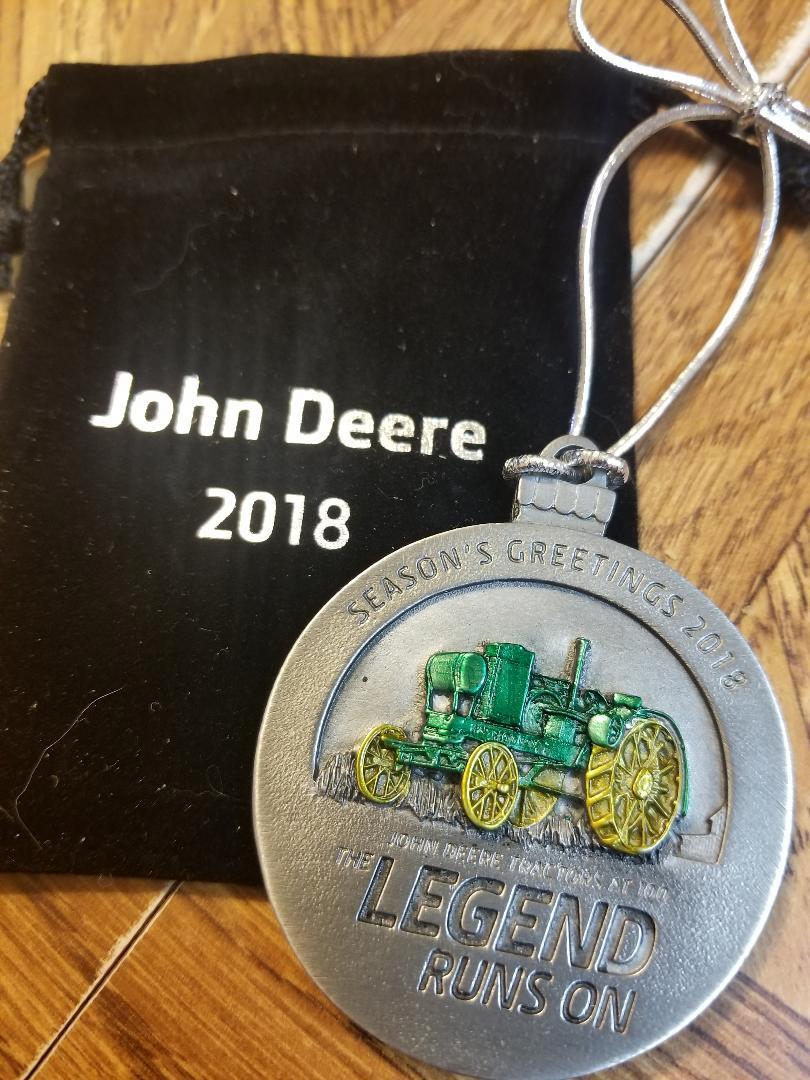
Butter Sculptures to Christmas Ornaments: Waterloo Boy Tractor Celebrates 100 Years
It’s hard to imagine a time when John Deere wasn’t a powerhouse in the tractor business. Yet, John Deere wouldn’t enter the farm tractor business until March 1918 through the acquisition of the Waterloo Gasoline Engine Company, and it’s a milestone that has been commemorated in everything from butter to Christmas ornaments.
Deere has featured a picture and story depicting the 100th anniversary of the iconic Waterloo Boy on its 2018 Christmas ornament. The 2018 Iowa State Fair also honored the tractor by featuring the world-famous Butter Cow beside a butter sculpture of the Waterloo Boy. Both butter masterpieces were displayed in the 114-year old John Deere Agriculture Building’s 40-degree cooler throughout the fair, which ran from August 9-19.
The Iowa State Fair has long been a prime venue to display Deere equipment in its various forms. A quote from the John Deere Sales Department in 1940 read, “I feel that the machinery and industrial exhibits for 1940 excelled any previous year’s display,” according to history shared by the Iowa State Fair. “We consider our Iowa State Fair exhibit to be a very beneficial part of our advertising program, and we will be with you again in 1941.’”
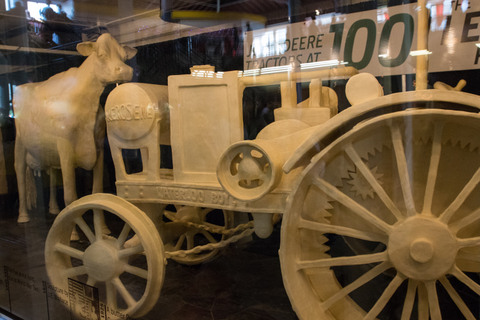
Waterloo Boy butter sculpture 2018 Iowa State Fair
Meeting the challenge of a reliable, durable tractor
Frequently ranked as one of the top events in the country, the Iowa State Fair is the single largest event in the state of Iowa and one of the oldest and largest agricultural expositions in the country and annually attracts more than a million people from all over the world.
In 2018, the Iowa State Fair used more than 50 John Deere tractors and utility vehicles provided by Van Wall Equipment. In addition, a 1919 Waterloo Boy model N tractor was on display in the Machinery Grounds at the Iowa State Fair.
To understand the significance of the Waterloo Boy, take a trip back in time, said Neil Dahlstrom, manager of the John Deere Archives and History. In the critical five-year stretch (1912-1917) prior to John Deere entering the tractor business, there were two key issues the company needed answered.
“First, what did farmers really want from a machine that would soon make the horse obsolete?” said Dahlstrom, who noted that salesmen, territory and branch managers, and Deere’s top leadership scoured the country to understand what customers desired.
Also, how could the equipment to be manufactured to be durable enough to stand up to daily farm use?
Deere had considered every imaginable idea. The company had developed one-, two- and four-cylinder concept tractors. Some ran on gasoline. Others ran on kerosene. Some had all-wheel drive. Others had front-wheel drive. The company even explored concepts like line steering, which was meant to replicate horse reins as the steering mechanism to ease farmers into power farming, Dahlstrom said.
A motorized cultivator, what Deere called a “Tractivator,” was brought to market by several competitors, but Deere determined it did not provide any cost savings compared to horses.
The challenge of producing a durable tractor loomed large. In a letter to company president William Butterworth in 1915, Deere’s superintendent of factories George Mixter noted that tractors offered by competitors up to that point “have not been built with the proper spirit behind the design and manufacture to insure their durability in the hands of the farmers.” But if Deere could “build a small tractor that will really stand up for five or more years’ work on the farm, I believe they will be a permanent requirement of the American farmer,” Mixter wrote.
Deere ultimately found the solution with the Waterloo Boy tractor and acquired the Waterloo Gasoline Engine Company in Waterloo, Iowa, on March 14, 1918. Although anxious to start selling the Waterloo Boy, Deere dealers had to wait while Deere honored existing contracts, which did not expire until Dec. 31, 1918, Dahlstrom said.
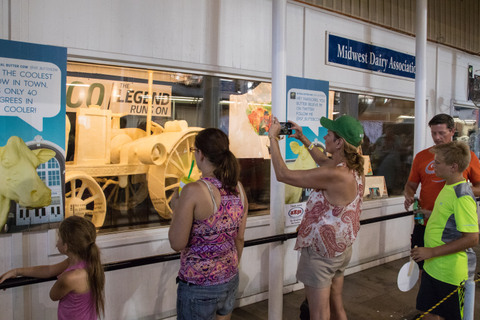
Visitors snapped photos of the iconic Waterloo Boy butter sculpture 2018 Iowa State Fair.
Waterloo Boy makes its debut
Deere put its money where its instincts were. Over the next year, the company spent more than one-third of its advertising budget touting the Waterloo Boy tractor, Dahlstrom said.
Specifically, Deere invested $50,000 on tractor advertising in the year following its debut of the Waterloo Boy—approximately $747,000 in today’s money. Another way to get the company’s new product out in front of customers was to take it on the road – literally.
The National Tractor Demonstrations started to become more mainstream after being introduced in the United States in 1913. An eight-city, eight-week tour schedule was the perfect opportunity to unveil Deere’s Waterloo Boy, Dahlstrom said. Salina, Kansas, served as the ideal backdrop in August 1918, since this was the nation’s largest demonstration.
Deere had participated in tractor demonstrations since the original Winnipeg Agricultural Motor Competitions in Manitoba, Canada, in 1908 – but not with a tractor. Instead, Deere had paired its plows with leading tractor manufacturers. That changed now that the Waterloo Boy was part of the Deere family.
At Salina, Deere spared no expense, showcasing 12 Waterloo Boy tractors as the centerpiece of a display that included John Deere signs, Waterloo Boy signs and a copper leaping deer statue, Dahlstrom said. “There were two stars during this week of 100-degree days – ‘ice water on tap’ and the Waterloo Boy Model ‘N’ tractor,” he added.
The Model “N” demonstrated its merits by pulling tractor plows, disc harrows and grain drills. Visitors were shuttled in three John Deere farm wagons pulled by Waterloo Boy tractors. By all accounts, the debut was a success.
“The award for the most elaborate, largest and most artistic exhibit tent at the Salina tractor show will undoubtedly go to the John Deere Plow company of Kansas City,” wrote the editors of a Kansas City newspaper.
As Deere’s advertising campaign swung into full gear, the Waterloo Boy tractor was promoted as the “best and most efficient tractor” on the market for farmers inclined to buy a tractor. By October 1918, readers of Deere’s magazine, The Furrow, saw an advertisement for the line of Waterloo Boy tractors and stationary engines. The ad guaranteed the Waterloo Boy’s “ample power for field and belt work.”
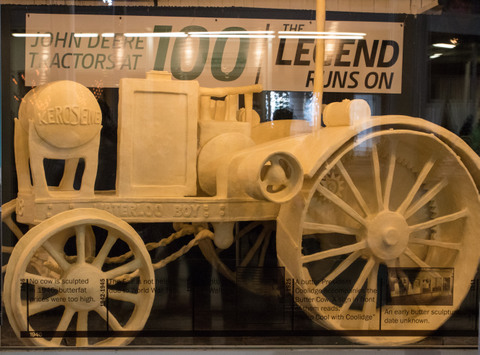
Waterloo Boy butter sculpture 2018 Iowa State Fair
In January 1919, with tractors now available through John Deere dealers, Deere’s first print ad for the trade press appeared in The Farm Implement News. It featured two areas of emphasis: “A Good Tractor Backed by a Permanent Organization.”
After years of development, John Deere customers and John Deere dealers finally had their John Deere tractor.
“It took longer than the company expected, but a determination to do it right instead of doing it fast now brought the John Deere tractor to market,” Dahlstrom said.
As a result, customers got “the assurance of more tractor work per dollar of fuel cost; longer tractor life with less repair cost; accessibility of parts that makes caring for the tractor simple and easy; and dependable power for all farm work.”
The tractor era had officially arrived.
Want more?
Thanks for stopping by. I invite you to read more of my blog posts if you value intriguing Iowa stories and history, along with Iowa food, agriculture updates, recipes and tips to make you a better communicator.
If you like what you see and want to be notified when I post new stories, be sure to click on the “subscribe to blog updates/newsletter” button at the top of this page, or click here. Feel free to share this with friends and colleagues who might be interested, too.
Also, if you or someone you know could use my writing services (I’m not only Iowa’s storyteller, but a professionally-trained journalist with 20 years of experience), let’s talk. I work with businesses and organizations within Iowa and across the country to unleash the power of great storytelling to define their brand and connect with their audience through clear, compelling blog posts, articles, news releases, feature stories, newsletter articles, social media, video scripts, and photography. Learn more at www.darcymaulsby.com, or e-mail me at yettergirl@yahoo.com.
If you’re hungry for more stories of Iowa history, check out my top-selling “Culinary History of Iowa: Sweet Corn, Pork Tenderloins, Maid-Rites and More” book from The History Press. Also take a look at my latest book, “Dallas County,” and my Calhoun County” book from Arcadia Publishing. Both are filled with vintage photos and compelling stories that showcase he history of small-town and rural Iowa. Order your signed copies today! Iowa postcards are available in my online store, too.
Let’s stay in touch. I’m at darcy@darcymaulsby.com, and yettergirl@yahoo.com.
Talk to you soon!
Darcy
@Copyright 2018 Darcy Maulsby & Co. Blog posts may only be reprinted with permission from Darcy Maulsby.
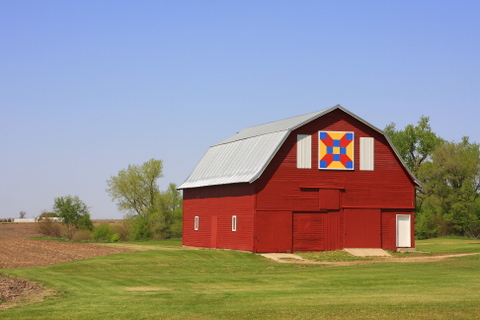
Pieced Together: Barn Quilt Documentary Features Iowa Stories
Barn quilts have become a folk-art phenomenon in Iowa in the past 15 years, turning up not only on barns, but mailboxes, gardens, buildings in town and more. But there was a time not that long ago when no one had ever heard of a barn quilt—not until Donna Sue Groves wanted to add a little color to her corner of the world.
Her story—and those of barn quilt enthusiasts in places like Sac County—inspired the 53-minute documentary “Pieced Together,” which filmmaker Julianne Donofrio showed in Sac City to a full house at the First Christian Church on the evening of Sept. 24, 2018.
“A lot of people don’t know where barn quilts came from,” said Donofrio, who is from the New York City/Washington, D.C. area. “I want people to know Donna Sue’s story.”
The story, which includes many barn quilts across Iowa, began in 1989 when Groves’ family bought a farm in Adams County, Ohio, near the Ohio River Valley at the foothills of the Appalachian Mountains. Groves made a casual remark to her mother, Nina Maxine Groves, about an uninspiring, time-worn tobacco barn on the farm.
“It was the ugliest barn I’d ever seen,” Groves said in “Pieced Together.” “I joked to my mother, ‘I’ll paint you a quilt square on it someday.’”
Game inspires a lifelong love of barns
Groves’ interest in barns dates back to her childhood. When her family would visit Groves’ grandmother in Roane County, West Virginia, Groves’ mother invented a car game to keep Groves and her brother quiet.
“You couldn’t play the typical license plate game when you’re traveling the back roads of West Virginia, because all you saw were West Virginia license plates,” Groves said. “Mother created a car game where we counted barns.”
Some barns were worth two points, while others were worth three points. If a barn had outdoor advertising, like “Chew Mail Pouch” or “RC Cola,” players got a 10-point bonus if they could read the lettering. Red barns also earned higher points. The chance to earn even more points awaited when the family’s wider travels took them past Pennsylvania Dutch barns with colorful, geometric hex signs.
The game led to discussions and questions about the barns, such as who built the barns, and for what purpose. Groves enjoyed these conversational teaching moments. “I looked forward to seeing barns,” she said.
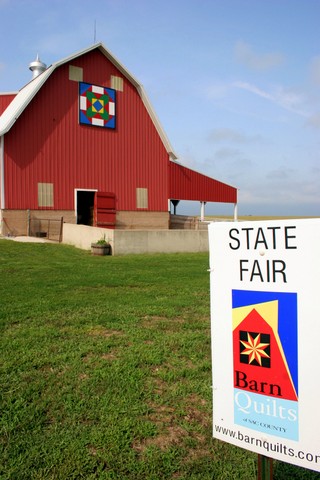
Sac County Iowa barn quilt
Creating a clothesline of quilts across America
This history eventually inspired Groves’ involvement with the first barn quilt square, an Ohio Star pattern, which was created in October 2001 and displayed in Adams County, Ohio. This small gesture triggered a ripple effect across North America.
“If we didn’t pick up on this idea, someone else would,” said Groves’ mother, Maxine, who was featured in “Pieced Together.”
As more people wanted to create barn quilts, Groves and her fellow volunteers quickly learned that painting barn quilts directly onto barns didn’t work too well, but painted plywood squares offered a much better option.
Why stop with just a few barn quilts, though? “A trail of barn quilts could bring tourists here to see all the wonderful things Adams County offers,” noted Groves, who has served as a field representative for the Ohio Arts Council. “Then they’d stay in our bed-and-breakfasts and motels and eat at our restaurants.”
These opportunities for economic development, combined with the visual appeal of barn quilts, soon inspired a “clothesline of quilts” across America. Residents of an adjoining county, Brown County, Ohio, loved Groves’ idea and asked how to get involved. Folks in Tennessee read an article about the Ohio barn quilt project, called Groves and wanted to know how to do a similar project in their area. Grundy County, Iowa, also got involved in 2003, followed by Sac County.
When Sue Peyton and her family from rural Sac City heard about barn quilts, it seemed like a good fit for her son, Kevin, who was in high school and looking for a project he could use as a 4-H leadership project and a Herbert Hoover Uncommon Student Award project.
“I immediately fell in love with the project when I heard about it,” Sue Peyton said. “Barns and barn quilts are such a natural fit.”
The Peytons coordinated the construction and painting of Sac County’s first barn quilts in the summer of 2005. While some people weren’t quite sure what to make of the new barn quilts that started appearing on barns and corncribs around the county, the concept caught on quickly. “We hoped to get 20 barn quilts,” said Sue Peyton, who added that Sac County boasted 55 barn quilts within two years of the start of the project.
“I’ve seen a lot of quilt trails, and you embraced this early on and have done a tremendous job,” said Donofrio as she chatted with audience members in Sac City following her documentary.

Sac County barn quilt proponents Kevin Peyton and his mother, Sue, (center) welcomed filmmaker Julianne Donofrio, who showed her 53-minute documentary “Pieced Together” in Sac City to a full house at the First Christian Church in September 2018.
“We’re here to stay”
Anywhere there’s a barn quilt trail, every square tells a story. Also, there’s no right or wrong way to create a barn quilt. “Barn quilts have a storied history as complex and diverse as the quilt patterns themselves,” Kevin Peyton said.
Consider the Double Aster barn quilt pattern on the Hogue family’s 1943 barn north of Odebolt. The pastel-colored design complements the family’s Prairie Pedlar Gardens business. Owner Jane Hogue, who served on the original Sac County Barn Quilt Committee, enjoyed watching the “Pieced Together” documentary.
“It was fun to see the snippets of Sac County’s barn quilts in the film,” she said. “We’re proud to be part of Sac County’s barn quilt project. With our gardens and tourism, it’s a win-win.”
Sac County proves that barn quilts offer an effective way to help save barns, promote rural tourism and boost economic development, Sue Peyton added. She cited the vintage barn at the Rustic River Winery and Vineyard north of Lake View, for example. It has been remodeled not only into a winery, but a venue where people can host parties and other gatherings.
As the history of the barn quilt phenomenon is preserved through projects like “Pieced Together,” barn quilts are being praised as one of the greatest community art projects ever created. While there are barn quilt trails in 42 states, there is no national barn quilt organization, by design. Creating barn quilts at the local allows local people to make their mark, share their history and establish a legacy. “It’s so adaptable—that’s the beauty of it,” Groves said.
Above all, barn quilts inspire people to view rural communities in a new way. “Barn quilts prompt a question that starts a discussion,” noted a speaker in the “Pieced Together” documentary. “It’s a statement that, ‘We’re here, and we’re here to stay.’”
Barn quilts also prove the power of one person from an isolated rural county to inspire a vision that has touched an entire nation. “As times get harder, we forget how to dream,” said Groves, a cancer survivor. “I like to think the barn quilt trails allow people to dream.”
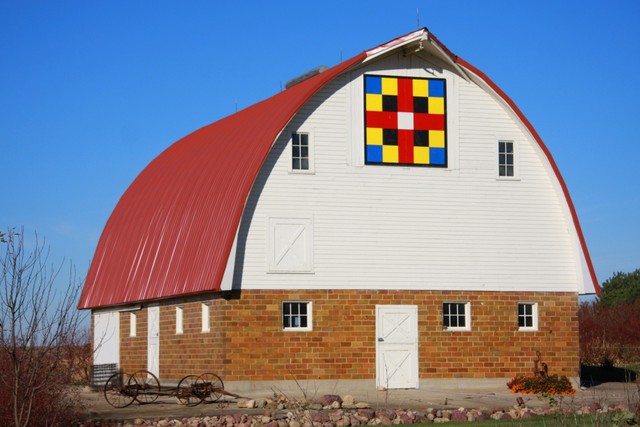
Sac County barn quilt near Early, Iowa
Want more?
Thanks for stopping by. I invite you to read more of my blog posts if you value intriguing Iowa stories and history, along with Iowa food, agriculture updates, recipes and tips to make you a better communicator.
If you like what you see and want to be notified when I post new stories, be sure to click on the “subscribe to blog updates/newsletter” button at the top of this page, or click here. Feel free to share this with friends and colleagues who might be interested, too.
Also, if you or someone you know could use my writing services (I’m not only Iowa’s storyteller, but a professionally-trained journalist with 20 years of experience), let’s talk. I work with businesses and organizations within Iowa and across the country to unleash the power of great storytelling to define their brand and connect with their audience through clear, compelling blog posts, articles, news releases, feature stories, newsletter articles, social media, video scripts, and photography. Learn more at www.darcymaulsby.com, or e-mail me at yettergirl@yahoo.com.
If you’re hungry for more stories of Iowa history, check out my top-selling “Culinary History of Iowa: Sweet Corn, Pork Tenderloins, Maid-Rites and More” book from The History Press. Also take a look at my latest book, “Dallas County,” and my Calhoun County” book from Arcadia Publishing. Both are filled with vintage photos and compelling stories that showcase he history of small-town and rural Iowa. Order your signed copies today! Iowa postcards are available in my online store, too.
Let’s stay in touch. I’m at darcy@darcymaulsby.com, and yettergirl@yahoo.com.
Talk to you soon!
Darcy
@Copyright 2018 Darcy Maulsby & Co. Blog posts may only be reprinted with permission from Darcy Maulsby.

Sac County Barn Quilt Attracts National Attention
When Alvin (Al) Liske and his wife, Jean, signed up for the Barn Quilts of Sac County project, they had no idea how much attention this would attract to their stately World War II-era barn west of Early, Iowa.
“Our barn has been featured in Eleanor Burns’ book, ‘Quilt Blocks on American Barns,’ and it was also included on the cover of the Department of Transportation’s 2009 map of Iowa,” said Jean.
Burns, a popular television personality who gained famed for her “Quilt in a Day” system, visited the Liske barn last year when she traveled to Iowa to participate in the Sac County Quilt-a-Fair. She was especially intrigued by the Country Lanes barn quilt pattern that graces the barn’s haymow door. She noted that Country Lanes is a very old pattern that was originally published by Mountain Mist, a company that began selling quilt batting in Cincinnati in 1846.
“We chose the Country Lanes block, because we live on a gravel road,” said Jean, who works in the registrar’s office at Buena Vista University in Storm Lake. “Even though we’re off the beaten path, it’s not uncommon to see people drive out here and take photos of the barn.”
Jean’s father, Herman Puetz, built the barn for approximately $4,000 around 1943 or 1944 on the Boyer Valley Township farm that his family had purchased in 1930. The new barn replaced an existing barn that was made from cottonwood lumber. After the concrete foundation for the new barn was poured, lumber was not readily available for the building, due to the war. In the meantime, the family roller skated on the concrete slab. “When construction started again, I can also remember going with my parents to Albert Lea, Minn., to get the rafters for the barn, and I thought that was a really long trip,” said Jean, who noted that the barn includes glazed tile on the bottom and originally had wood shingles on the rounded, gothic roof.
Herman kept horses in the barn, said Jean, who added that farming with horses could be dangerous. “One time when my Uncle George was hauling manure on our farm, something spooked the horses, and they ran toward a barbed wire fence. My uncle jumped off, and he broke his ankle, which got infected.”
Jean’s father, who was one of 12 children, also milked cows on the east side of the barn and kept plenty of hay in the haymow. “I’d play in the barn with my brothers and sister, and we’d make tunnels and caves and houses with the bales. When enough hay had been fed, there would be bare spots in the haymow, and we’d play basketball up there,” said Jean, who noted that the haymow still includes basketball hoops.
After Jean married Al and the couple moved to the farm where Jean grew up, the Liskes raised cattle and hogs in the barn and farmed from the early 1960s until the 1980s. In 2005, the couple decided to remodel the barn, which still had a good foundation. “It was getting to the point where we needed to fix up the barn or think about tearing it down, and we didn’t want to watch the barn fall down,” said Jean, who noted that the family power washed the interior, rebuilt windows and doors, had the barn rewired, covered the roof with red steel and added a staircase to the haymow.
The barn, which is now used for storage, became
a favorite play area for the Liske’s grandchildren. “The barn is an important part of our family’s heritage, and it’s one of the few old buildings left on this farm,” Jean said. “My dad was always proud of the barn, and we’re glad we’ve maintained it.”
Note from Darcy: I first wrote this piece in 2010 for Farm News.
Want more?
Thanks for stopping by. I invite you to read more of my blog posts if you value intriguing Iowa stories and history, along with Iowa food, agriculture updates, recipes and tips to make you a better communicator.
If you like what you see and want to be notified when I post new stories, be sure to click on the “subscribe to blog updates/newsletter” button at the top of this page, or click here. Feel free to share this with friends and colleagues who might be interested, too.
Also, if you or someone you know could use my writing services (I’m not only Iowa’s storyteller, but a professionally-trained journalist with 20 years of experience), let’s talk. I work with businesses and organizations within Iowa and across the country to unleash the power of great storytelling to define their brand and connect with their audience through clear, compelling blog posts, articles, news releases, feature stories, newsletter articles, social media, video scripts, and photography. Learn more at www.darcymaulsby.com, or e-mail me at yettergirl@yahoo.com.
If you’re hungry for more stories of Iowa history, check out my top-selling “Culinary History of Iowa: Sweet Corn, Pork Tenderloins, Maid-Rites and More” book from The History Press. Also take a look at my latest book, “Dallas County,” and my Calhoun County” book from Arcadia Publishing. Both are filled with vintage photos and compelling stories that showcase he history of small-town and rural Iowa. Order your signed copies today! Iowa postcards are available in my online store, too.
Let’s stay in touch. I’m at darcy@darcymaulsby.com, and yettergirl@yahoo.com.
Talk to you soon!
Darcy
@Copyright 2018 Darcy Maulsby & Co. Blog posts may only be reprinted with permission from Darcy Maulsby.
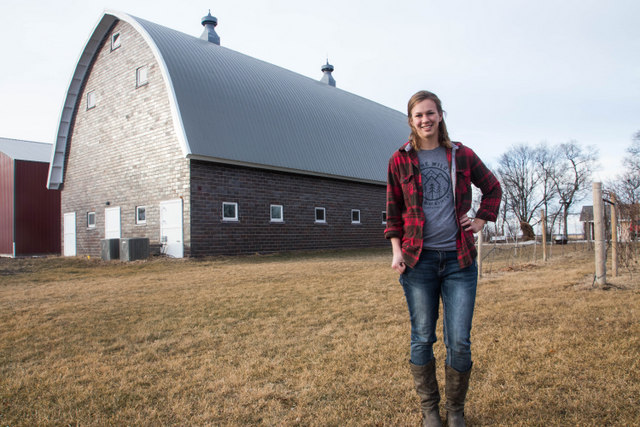
Events Spark Stories That Help Backcountry Winery Grow in Iowa
Ask Amber Gable about the back story behind Backcountry Winery at her family’s home east of Stratford, and her answer is straightforward. “It’s a hobby out of control.”
That hobby has taken Gable and her husband, Preston, on dynamic journey that has led to the creation of a small business that’s helping spur economic development in rural Iowa. At the heart of it all is a century-old barn that’s central to the story, offering an attractive venue for gatherings, celebrations, music concerts and more.
“This barn is such a unique building,” said Amber Gable, 27, who grew up on a farm near Sibley. “There’s so much history here, including original interior boards that have Stratford Grain and Supply stamped on them.”
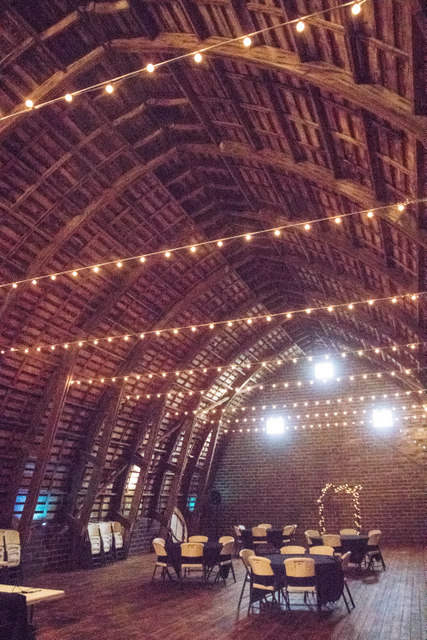
Beyond the tasting room on the main floor, the barn loft holds 150 people.
Guests who come to Backcountry Winery for bridal showers, wedding receptions, class reunions and other celebrations enjoy exploring this rural heritage. So do the visitors who stop by for Backcountry Winery’s live music events.
“When we’re open on Saturday afternoons without a special event like live music, we tend to have smaller crowds,” Gable said. “Events help create experiences that people seek out.”
Events of all types have become an increasingly important part of running a successful winery, noted Mike White, a viticulture specialist for Iowa State University Extension. “More wineries are realizing that there’s big potential in event centers, and many are going this way.”
Putting down roots in Hamilton County
For many guests, part of the experience involves learning the story of the winery. In the case of Backcountry Winery, that story began with Preston Gable’s long-time interest in home winemaking.
“We’d talk about how we might open a winery someday,” said Amber Gable, whose husband is a fellow northwest Iowa native from Hartley.
“Someday” seemed far off, however, when the high school sweethearts started their careers in Ames following their graduation from Iowa State University (ISU). Amber Gable became a landscape designer for an engineering firm, while her husband worked in biofuels research at ISU.
When the couple began looking for an affordable acreage in central Iowa where they could establish a home, start a family and maybe operate a winery eventually, the process became frustrating at times. “We actively looked for about a year and often came up with nothing,” Amber Gable said. “There were some tears along the way.”
Things turned around in 2014, though, when the young couple found an acreage with a house and barn northeast of Stratford. “We really needed a fixer-upper, and this place needed a family to put down roots,” Amber Gable said.
After the couple purchased the property in August 2014, they began remodeling the barn within a few months and exploring its history. The abstract for the property goes back to 1920, when the current home on the acreage was built by Alfred Erickson. “We know the barn pre-dates 1920, although we don’t know exactly when it was built,” Amber Gable said.
While the barn is structurally sound, time had taken a toll on some parts of the building. “We poured a new concrete floor and replaced the entire hayloft floor,” said Amber Gable, who noted that the barn once housed cattle.
After months of work, the Gables opened Backcountry Winery in May 2016. “The barn is still a work in progress, but it has allowed us to open our winery sooner than we anticipated,” said Amber Gable, who appreciates the opportunity to run a home-based business, especially now that she and her husband are raising their 1-year-old son, Ivan.
Word-of-mouth marketing, Backcountry Winery’s website and a Facebook page have helped the couple’s business grow. While Backcountry Winery hosted one wedding in 2016, this grew to five weddings in 2017 and has increased to seven weddings slated for 2018.
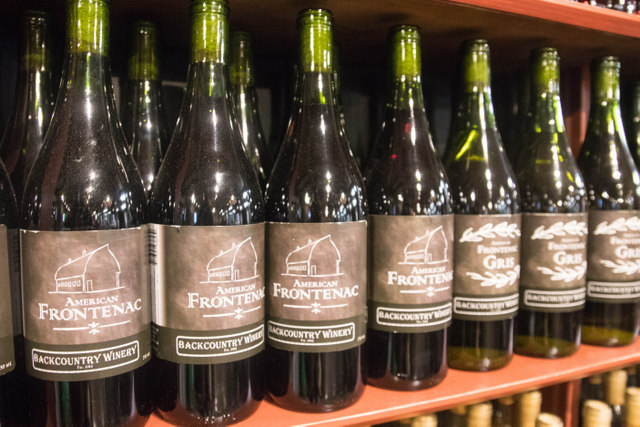
At Backcountry Winery, the Gables grow six varieties of wine grapes. They make 12 different wines, including strawberry, raspberry, cherry and apple wines, and plan to expand to 14 wines soon.
The Gables have invested in an expansion near the barn to accommodate these events. A connecting space on the west side of the barn will include a room when brides can get ready for their wedding. This connecting space is attached to a 60-foot by 90-foot addition that will provide additional production space, storage space and office space for the winery.
This infrastructure is just one part of Backcountry Winery’s recent expansions. While the Gables maintain a vineyard on the east side of the barn, the couple also began leasing an established, 4-acre vineyard near Webster City in the spring of 2017.
“It’s exciting to raise more of our own grapes so we can produce estate wines, which are made from our own crop,” said Amber Gable, who is a member of the Iowa Wine Growers Association. “There’s a great deal of pride in that.”
Wine wins big at Iowa State Fair
This pride is reflected in the large, silver trophy that graces the barn at Backcountry Winery. When the Gables competed in the commercial wine competition at the 2017 Iowa State Fair, the judges selected Vignoles from Backcountry Winery for the top honor, the Governor’s Cup. Vignoles is a semi-dry white wine that boasts crisp flavors of tropical and citrus fruits and a clean finish.
Vignoles is just one of the wines available from Backcountry Winery, where the Gables grow six varieties of wine grapes. They make 12 different wines, including strawberry, raspberry, cherry and apple wines, and plan to expand to 14 wines soon.
Backcountry Winery’s products can be purchased at the winery or through the approximately 25 retailers in Hamilton County and central, northern and northwest Iowa that partner with Backcountry Winery.
Raising specialty crops like wine grapes and offering Iowa wines offer unique opportunities to boost economic development in rural Iowa, Amber Gable said. “When visitors come to our winery, they not only buy wine, but they buy fuel at the convenience store in Stratford, which is owned by the local co-op, and they can go to Stanhope to get a burger. It’s rewarding to promote the whole Hamilton County experience.”
The Gables hope to attract more guests to the area by offering more live music this summer at the winery. This builds on the success of the three performances offered in 2016 and the 10 shows offered in 2017. The 2018 concerts, which range from country to classic rock, cost $5 for admission and will be held on certain Saturdays from 6 p.m. to 8 p.m. in the barn.
“Visiting a winery is all about the experience,” Amber Gable said. “We enjoy creating these memorable experiences, meeting people from across Iowa and beyond and promoting rural Iowa.”
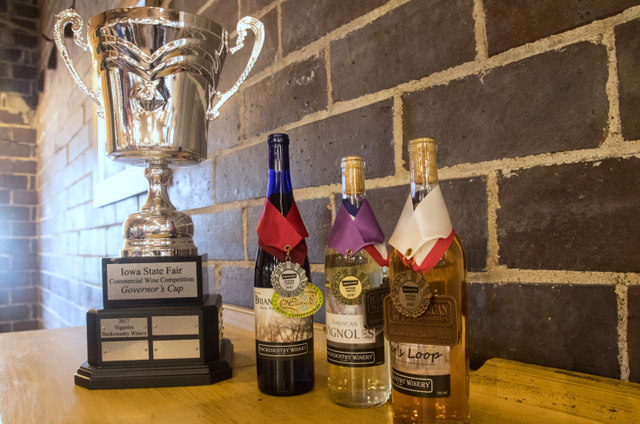
When the Gables competed in the commercial wine competition at the 2017 Iowa State Fair, the judges selected Vignoles from Backcountry Winery for the top honor, the Governor’s Cup. Vignoles is a semi-dry white wine that boasts crisp flavors of tropical and citrus fruits and a clean finish.
Iowa’s Wine Industry, By the Numbers
Data from the Iowa Wine Growers Association (IWGA) shows that Iowa has:
• 103 wineries
• 267 vineyards
• 1,300 acres of grapes
• 8 wine trails
• 40+ cold-climate grapes grown
• $420 million of economic impact in 2012
• 2,600 full-time jobs
• 358,000 wine related tourists per year
On average, the typical Iowa winery produces approximately 3,000 gallons of wine annually. The Iowa native wine industry helps promote and establish additional activity in the state, including lodging, food, travel, gifts, agri-tourism, event centers, festivals, music, art and a host of service industries.
“By our estimation, based on direct feedback from the wineries we surveyed, there was over $2.1 million in revenue generated from these wine-related events and facilities,” according to the 2012 “Economic Impact of Iowa Wine and Wine Grapes” report produced by Frank, Rimerman + Co, LLP.
In order for the industry to keep growing and attracting new visitors, wineries not only need to continue focusing on improving wine quality, but consider expanding into more wine-related events like private parties, weddings and festivals held on winery properties, according to the report.
- I originally wrote this story for the Progress section of Farm News, Ft. Dodge, Iowa in February 2018.
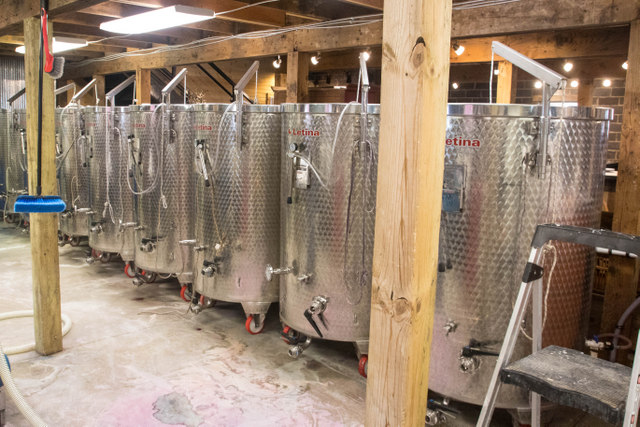
Backcountry Winery’s fermenting equipment is housed in a Hamilton County, Iowa, barn that’s approximately 100 years old.
Want more?
Thanks for stopping by. I invite you to read more of my blog posts if you value intriguing Iowa stories and history, along with Iowa food, agriculture updates, recipes and tips to make you a better communicator.
If you like what you see and want to be notified when I post new stories, be sure to click on the “subscribe to blog updates/newsletter” button at the top of this page, or click here. Feel free to share this with friends and colleagues who might be interested, too.
Also, if you or someone you know could use my writing services (I’m not only Iowa’s storyteller, but a professionally-trained journalist with 20 years of experience), let’s talk. I work with businesses and organizations within Iowa and across the country to unleash the power of great storytelling to define their brand and connect with their audience through clear, compelling blog posts, articles, news releases, feature stories, newsletter articles, social media, video scripts, and photography. Learn more at www.darcymaulsby.com, or e-mail me at yettergirl@yahoo.com.
If you’re hungry for more stories of Iowa history, check out my top-selling “Culinary History of Iowa: Sweet Corn, Pork Tenderloins, Maid-Rites and More” book from The History Press. Also take a look at my latest book, “Dallas County,” and my Calhoun County” book from Arcadia Publishing. Both are filled with vintage photos and compelling stories that showcase he history of small-town and rural Iowa. Order your signed copies today! Iowa postcards are available in my online store, too.
Let’s stay in touch. I’m at darcy@darcymaulsby.com, and yettergirl@yahoo.com.
Talk to you soon!
Darcy
@Copyright 2018 Darcy Maulsby & Co. Blog posts may only be reprinted with permission from Darcy Maulsby.
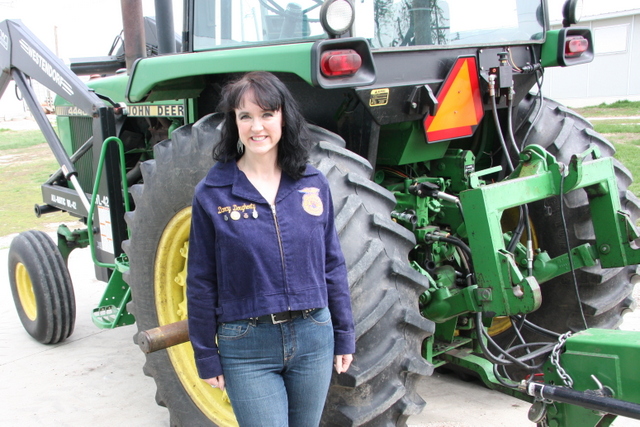
Recalling a Most Unconventional—and Life-Changing–FFA Journey
My FFA story is so unlikely that even I can’t quite believe it myself. It all began in the fall of 1989, when I was starting my sophomore year at Southern Cal High School in Lake City.
As a child of a Farm Crisis, I never thought about joining FFA. I was busy with classes, band, choir, theater and other activities, and the unspoken message was clear—ag has no future, so don’t spend your time there. Then along came Ed Ricks.
Ed was Southern Cal’s ag teacher and FFA advisor. Turns out he was also a talent recruiter. He asked me whether I’d be interested in coming over to the ag building and studying ag rather than taking the standard 10th grade biology class. I was intrigued. Ed worked out an arrangement with the biology teacher so I could skip biology class every day and instead focus on ag, as long as I could pass the biology tests.
No problem.
What a golden opportunity this turned out to be. I discovered a whole new world of learning, plus I didn’t have to be bored in a biology class. (And yes, I always passed the tests.)
I’m forever grateful that Ed welcomed me into the dynamic world of FFA. Not only did I love the ag classes, but it was fun to compete on the horticulture/floriculture team at nationals in Kansas City. My ag adventures truly set me a path that has defined my career for more than 20 years. They also explain why I’m sure a big believer in FFA.
As I look back, it’s amazing to think how much FFA has changed, and what hasn’t changed, since those days.
1. More diversity. When I was in FFA, there were usually only three to five girls at most in our chapter. That era wasn’t that far removed from the days when girls were not allowed to join FFA (a change that didn’t come until 1969.) Now girls often outnumber boys in many FFA chapters. I was excited that our local South Central Calhoun FFA chapter offered a Diversity in Ag class for the first time this fall, thanks to advisor Matt Carlson, to help girls learn more about the diverse career options available in ag today.
2. Ability to inspire. As I worked with the Diversity in Ag students, I remembered just how influential adults can be at this point in an FFA student’s life, and how much we can inspire the next generation of ag leaders, if we only take the time.
3. Learning made fun. While “fun” doesn’t come to mind when I think of most of my high school classes, it’s a word I’ve always associated with ag education. That all stems from my positive experiences in FFA, from working in our greenhouse to competing with teams that traveled from Ames to Des Moines to Kansas City.
4. Competition. Speaking of competition, I grew up in the era before everyone got a participation ribbon, and it made all the difference in my outlook on life. I loved competing on our floriculture/horticulture team. Even when I didn’t do well in certain categories likes salesmanship, I learned how to keep trying, keep learning and keep progressing. I also come from a legacy of FFA competitors. My Uncle Jack Dougherty competed in public speaking at the state FFA convention in Des Moines in 1956, where he focused on soil conservation. My family still quotes his words that “when the soil is gone, so are we.”
5. Real-world connections. These FFA lessons, from soil conservation to sales and communication skills, aren’t just academic theory. They have real-world applications that continue to influence my approach to business, farming and life.
6. Broadening your horizons. Being recruiting into FFA opened up a whole new world of career options I might never have considered. While there isn’t an abundance of children of the 1980s Farm Crisis working in agriculture, I consider myself to be one of the fortunate ones, all because Ed Ricks helped me broaden my horizons.
7. Useful knowledge you don’t learn anywhere else. When I’m at a meeting, I can tell who’s an FFA alum and who’s not, simply by whether a person knows how to conduct a meeting properly with parliamentary procedure. This is such a useful skill, and it’s curious to me that FFA is one of the few organizations that seems to understand its value.
8. Giving back. I remember helping plant and water the flowers in the planters around Lake City’s town square as part of our FFA training. While I just thought this was a fun way to get away from school for awhile, lessons like this helped plant the seed of community service in my life.
9. Leadership. As I volunteer with local FFA chapters today, I’m always inspired by the leadership opportunities that kids embrace at the chapter, district, state and even national levels. A dedicated FFA member always stands out among his or her peers. Some of FFA’s most notable alums have ascended to the highest levels of their chosen professions, from President Jimmy Carter to professional athletes like Bo Jackson to country music superstars Tim McGraw and Taylor Swift.
10. Focus on the future. As I look back, I knew I had a good thing going in high school with FFA, but I wish would have understood even better the amazing opportunities I had. It says a lot about an organization when you realize more of its value the longer you’ve been away from it.
It’s always interesting to me that FFA took root in the mid-1920s to counter the trend of boys losing interest in agriculture and leaving the farm. I think of my own FFA story and am still inspired by the wisdom reflected in the the FFA creed:
“I believe in the future of agriculture, with a faith born not of words but of deeds – achievements won by the present and past generations of agriculturists; in the promise of better days through better ways, even as the better things we now enjoy have come to us from the struggles of former years.”
Long live FFA!
P.S. Thanks for joining me. I’m glad you’re here.
Want more?
Thanks for stopping by. I invite you to read more of my blog posts if you value intriguing Iowa stories and history, along with Iowa food, agriculture updates, recipes and tips to make you a better communicator.
If you like what you see and want to be notified when I post new stories, be sure to click on the “subscribe to blog updates/newsletter” button at the top of this page, or click here. Feel free to share this with friends and colleagues who might be interested, too.
Also, if you or someone you know could use my writing services (I’m not only Iowa’s storyteller, but a professionally-trained journalist with 20 years of experience), let’s talk. I work with businesses and organizations within Iowa and across the country to unleash the power of great storytelling to define their brand and connect with their audience through clear, compelling blog posts, articles, news releases, feature stories, newsletter articles, social media, video scripts, and photography. Learn more at www.darcymaulsby.com, or e-mail me at yettergirl@yahoo.com.
If you’re hungry for more stories of Iowa history, check out my top-selling “Culinary History of Iowa: Sweet Corn, Pork Tenderloins, Maid-Rites and More” book from The History Press. Also take a look at my latest book, “Dallas County,” and my Calhoun County” book from Arcadia Publishing. Both are filled with vintage photos and compelling stories that showcase he history of small-town and rural Iowa. Order your signed copies today! Iowa postcards are available in my online store, too.
Let’s stay in touch. I’m at darcy@darcymaulsby.com, and yettergirl@yahoo.com.
Talk to you soon!
Darcy
@Copyright 2018 Darcy Maulsby & Co. Blog posts may only be reprinted with permission from Darcy Maulsby.
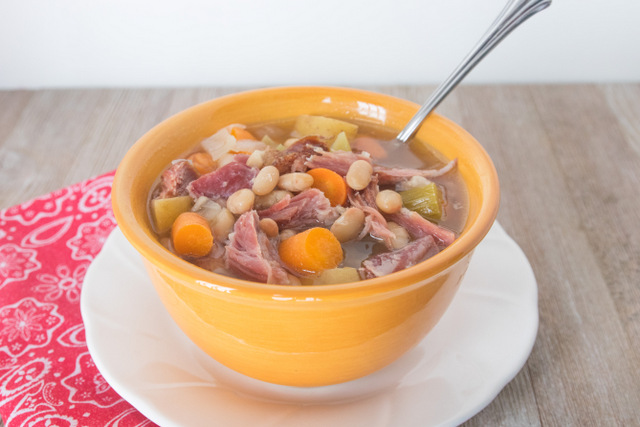
In Praise of Ham and Bean Soup
I’ve never understood why a smoky, delicious ham and bean soup is so hard to find. Heck, just a lackluster, ho-hum ham and bean soup is often hard to find.
I always figured no one knows more about ham and bean soup than Iowa farm cooks, especially when those who grew up on a hog farm like I did. Pork galore in all its forms was a staple on our family’s dinner table for generations. Plus, soup night was always Sunday night at our farm—and it still is. What a treat when ham and bean soup is on the menu!
With its rich broth and smoky undertones, there’s nothing like a hearty ham and bean soup to chase away the winter chill (or bitter cold, depending on what Mother Nature throws at us.) As I’ve refined my own recipe through the years, I’ve come to three conclusions:
1. You MUST have a thick, smoked ham hock (also known as a ham shank) to make the magic. No cubes of cured ham are going to cut it, if you want maximum flavor. This is a heavy-duty, low-and-slow kind of job for a tough, smoky ham shank.
2. We’re blessed to have many great meat lockers in Iowa, a reflection of our thriving livestock industry, where I can get fabulous smoked ham hocks. One of my favorite suppliers? Lewright Meats in Eagle Grove, which has been serving northern Iowa since 1936.
3. Adding diced potatoes is a good thing for ham and bean soup. I like to add oomph to my cooking, and how can you go wrong with extra veggies? Adding potatoes might be a bit non-traditional for ham and bean soup, but that’s how I roll.
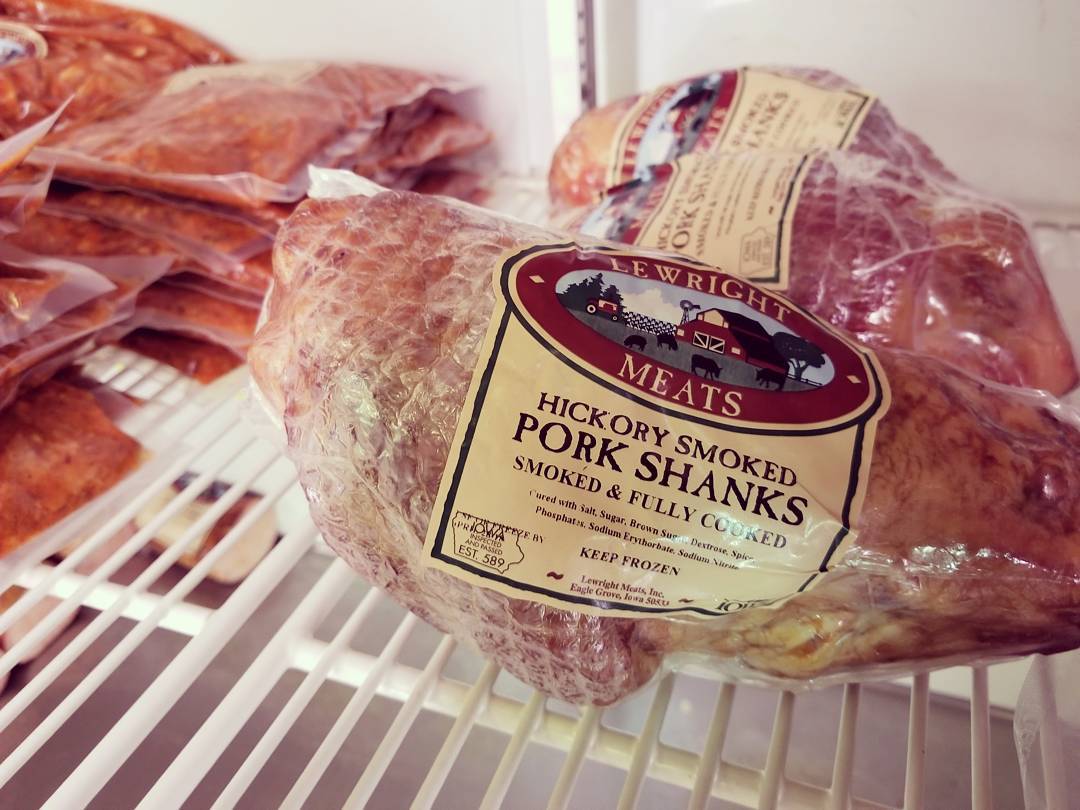
This smoked ham hock from Lewright Meats in Eagle Grove is the key to a great ham and bean soup.
The thing about ham and bean soup is that it can be a palette you fine-tune to your own tastes. Don’t like garlic? Leave it out. Want more onions in the mix? Add another one. (As my dear neighbor and farm cook extraordinaire Alice Ann Dial taught me, onions are a cheap way to add lots of flavor.)
The story behind Congress and Bean Soup
“Thunderation,” roared Speaker of the House Joe Cannon of Illinois. “I had my mouth set for bean soup! From now on, hot or cold, rain, snow, or shine, I want it on the menu every day.”
Obviously, ham and bean soup isn’t just a farm favorite. Turns out it has a rich history in the kitchens of Washington, D.C., too.
While ham and bean soup was a common item on the U.S. House of Representatives’ menu before the turn of the 20th century, it became a permanent fixture in the institution when Speaker Joe Cannon of Illinois discovered that his favorite meal had not been prepared by the kitchen staff on a hot, summer day in 1904.
Cannon, who was the namesake of the Cannon House Office Building, served in the U.S. House for 46 years. Dismayed by that egregious menu omission in 1904, the Speaker directed that bean soup be served in the House every day, regardless of the weather.
More than a century after Speaker Cannon’s decree, bean soup remains on the menu in the House Restaurant, making it one of the more longstanding and famous traditions in the House.
Members of the U.S. House aren’t the only fans of ham and bean soup. It’s also on the menu in the Senate’s restaurant every day. There are several stories about the origin of that mandate, but none has been corroborated.
According to one story, the Senate’s bean soup tradition began early in the 20th-century at the request of Senator Fred Dubois of Idaho. Another story attributes the request to Senator Knute Nelson of Minnesota, who expressed his fondness for the soup in 1903.
The recipe attributed to Dubois includes mashed potatoes and makes a 5-gallon batch. The recipe served in the Senate today does not include mashed potatoes, but does include a braised onion. Click here to check out both Senate recipes.
No matter how you like your ham and bean soup, here’s my take on this American classic. Enjoy, and let me know what you think.
Darcy’s Hearty Ham and Bean Soup
1 smoked ham hock (also called a smoked ham shank)—the meatier, the better
1 48-ounce jar great northern beans (I don’t drain and rinse the beans—I add it all)
3 stalks celery, diced
3 carrots, peeled and sliced
3 to 4 medium potatoes, diced (I prefer Yukon Golds)
1 large onion, chopped
1 tablespoon garlic, minced
1 teaspoon fresh-ground pepper
Water or chicken stock
Salt, to taste
Place ham hock in slow cooker. Add beans, celery, carrots, potatoes, onion, garlic and pepper. Cover with water or chicken stock until slow cooker is full. (If using water rather than chicken stock, I often add 2 or 3 teaspoons of Better Than Bouillon chicken soup base to add more flavor.)
Cook on low for 8 to 10 hours. (I often prepare the soup in the evening and let it cook overnight.) Remove ham hock, allow it to cool, and remove ham from the bone. Add ham back to the soup. Taste the soup to see if it needs salt. Add salt, if desired. (Some ham hocks add enough flavor to the broth that no salt is needed.)
• Note: homemade soup often develops more flavor if you let it sit in the refrigerator overnight and serve the soup the next day. This Hearty Ham and Bean Soup is so good, though, that I understand if you dig in right away!
P.S. Thanks for joining me. I’m glad you’re here.
Want more?
Thanks for stopping by. I invite you to read more of my blog posts if you value intriguing Iowa stories and history, along with Iowa food, agriculture updates, recipes and tips to make you a better communicator.
If you like what you see and want to be notified when I post new stories, be sure to click on the “subscribe to blog updates/newsletter” button at the top of this page, or click here. Feel free to share this with friends and colleagues who might be interested, too.
Also, if you or someone you know could use my writing services (I’m not only Iowa’s storyteller, but a professionally-trained journalist with 20 years of experience), let’s talk. I work with businesses and organizations within Iowa and across the country to unleash the power of great storytelling to define their brand and connect with their audience through clear, compelling blog posts, articles, news releases, feature stories, newsletter articles, social media, video scripts, and photography. Learn more at www.darcymaulsby.com, or e-mail me at yettergirl@yahoo.com.
If you’re hungry for more stories of Iowa history, check out my top-selling “Culinary History of Iowa: Sweet Corn, Pork Tenderloins, Maid-Rites and More” book from The History Press. Also take a look at my latest book, “Dallas County,” and my Calhoun County” book from Arcadia Publishing. Both are filled with vintage photos and compelling stories that showcase he history of small-town and rural Iowa. Order your signed copies today! Iowa postcards are available in my online store, too.
Let’s stay in touch. I’m at darcy@darcymaulsby.com, and yettergirl@yahoo.com.
Talk to you soon!
Darcy
@Copyright 2018 Darcy Maulsby & Co.
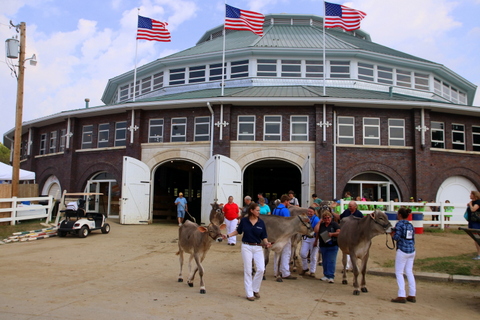
Iconic State Fair Architecture- Historic Buildings Reflect Decades of Memories
The Iowa State Fair is a homecoming for Iowans, and the historic buildings that grace the fairgrounds in Des Moines provide iconic venues for this statewide family reunion. There’s also a lot of surprising history behind many of these structures, from the Agriculture Building to the Livestock Pavilion.
“The Iowa State Fair connects generations of Iowans,” said Iowa Governor Kim Reynolds, who spoke during the opening ceremony of the 2017 Iowa State Fair on August 10. “There are so many wonderful memories and traditions here at the fair, which showcases the best of Iowa’s agricultural and cultural heritage.”
While the first Iowa State Fair was held October 25-27, 1854, in Fairfield, supported by a total operating budget of $323, the fair moved to its present location in 1886.
“The state fair moved to this site in Des Moines after the State Legislature and the City of Des Moines appropriated funds to purchase Calvin and Arminta Thornton’s farm,” said Leo Landis, state curator for the State Historical Society of Iowa, who helped lead an Iowa State Fair walking tour on Aug. 10. “One building original to the Thornton farm remains–Grandfather’s Barn, which is on the far eastern edge of the fairgrounds.”
Livestock Pavilion opened in 1902
Between the time the Fair Board purchased the land in June 1886 and when the fair opened in September 1886, crews constructed 67 buildings. “Of those, Pioneer Hall is the only one that remains today,” said Landis, museum curator at the State Historical Museum.
By the 1900 Iowa State Fair, most of the buildings built for the 1886 fair were still in use. They were beginning to show signs of decay, however, and roofs were particularly bad. It was time for the Iowa State Fair to clean up the fairgrounds.
One of the first new buildings added more than a century ago was the Livestock Pavilion. Back in 1901, more than 650 cattle were shown at the Iowa State Fair – only about 50 less than were shown that year at the International Stock Show at Chicago, Landis said. With future Iowa State Fairs expected to have even more cattle, the Iowa Legislature appropriated $37,000 for a fireproof steel-and-brick stock pavilion, similar to one that had just been constructed at the Illinois State Fairgrounds.
The Livestock Pavilion was the first major brick-and-steel structure built at the Iowa State Fairgrounds. “By constructing buildings out of these materials, the Fair Board gave the fair a sense of permanence and safety at this location,” said Landis, who noted that the new Livestock Pavilion officially opened for the 1902 fair and has been used for stock judging, lectures, entertainment and more for decades.
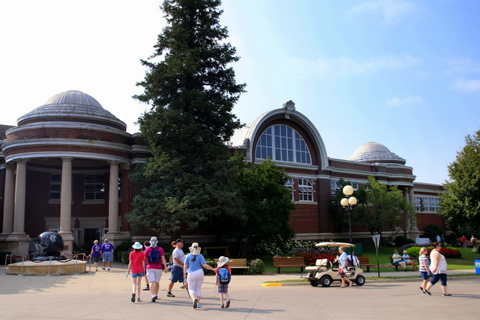
A new Agriculture Building was constructed in time for the 1904 Iowa State Fair. This famous building is home to the beloved Butter Cow. The Agriculture Building is one of the finest examples of Double Jeffersonian architecture remaining in the world.
1904 State Fair showcased new Agriculture Building
A new Agriculture Building came along two years later, in time for the 1904 Iowa State Fair. Located at the intersection of Grand Avenue and Rock Island Avenue, the Agriculture Building was built along the route to and from the State Fair from the Rock Island Railroad depot.
From the beginning, the Agriculture Building has been used as the agricultural, horticultural and dairy building. It’s home to the famous Butter Cow and other butter sculptures, which have been part of the Iowa State Fair since 1911.
“The Homestead,” a well-known farm newspaper of the late 1800s and early 1900s published in Des Moines, touted the new Agriculture Building as “one of the finest structures for exhibiting products of the farm that can be found in the Central West.”
The building’s design was inspired by the Exposition Halls at the Columbian Exposition, the world’s fair held in Chicago in 1893. The Agriculture Building is one of the finest examples of Double Jeffersonian architecture remaining in the world.
“Building a structure of such grand scale – with 33,800 square feet of floor space – suggested to visitors that the Iowa State Fair was an event of both civic and social importance,” said Jessica Rundlett, special projects and outreach coordinator at State Historical Museum of Iowa, who assisted with the Iowa State Fair walking tour.
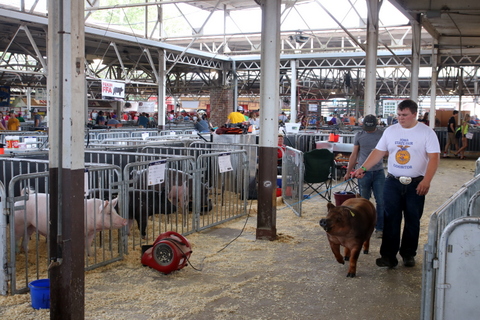
Kyle Andrews with the Wayne FFA chapter exhibited hogs during the 2017 Iowa State Fair. The Swine Barn was built in 1907.
Swine Barn design enhanced ventilation
When a new Swine Barn was constructed for the 1907 Iowa State Fair, the roof covered 185,000 square feet of stalls, exhibition areas and two central show rings that could seat more than 800 people. “The Homestead newspaper said you had to see it to believe its grand size,” Landis said.
The state appropriated $75,000 to build the Swine Barn. The building’s roof profile is designed to provide superior lighting and ventilation. The long open windows at roof level and open exterior walls draw in fresh air. Today you can see the Big Boar at the Swine Barn, as well as the Avenue of Breeds, which is coordinated by the North Polk FFA.
Horse Barn cost $25,000
The Horse Barn was completed in 1912 for $25,000 and renovated in 1929. Measuring 156 feet by 224 feet, the new barn could accommodate 132 draft horses and a like number of ponies, according to the Homestead newspaper. Th article also noted the new barn was equipped with water troughs, wash stands, sanitary feed mangers and automatic hayracks, Landis said.
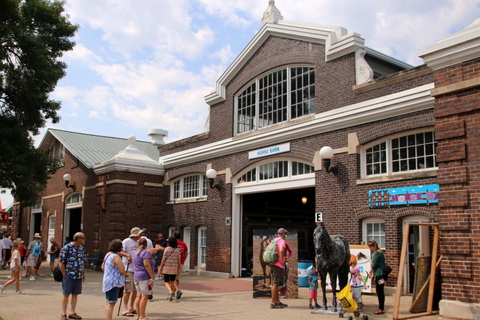
The Horse Barn was completed in 1912 for $25,000 and renovated in 1929.
Cattle Barn named for Iowa farmer
The Iowa State Fair’s building boom of the early twentieth century included the new Cattle Barn, which opened for the 1914 fair. While the original barn could accommodate 108 head of cattle, the barn now has ties for 1,600 cows, thanks to multiple expansions through the years.
Among the early proponents of Iowa’s cattle industry was Iowa Governor William Larrabee of Clermont, Landis noted. Larrabee helped introduced Brown Swiss dairy cattle to Iowa after studying the breed and concluding Brown Swiss were best suited for Iowa’s climate.
Today, the Cattle Barn is named for John Putney, a farmer from Gladbrook who was also a long-time cattle exhibitor, president of the Sale of Champions and beef superintendent. Putney was appointed the first executive director of the Blue Ribbon Foundation, which has raised more than $135 million in the last 25 years to renovate and preserve the Iowa State Fairgrounds.
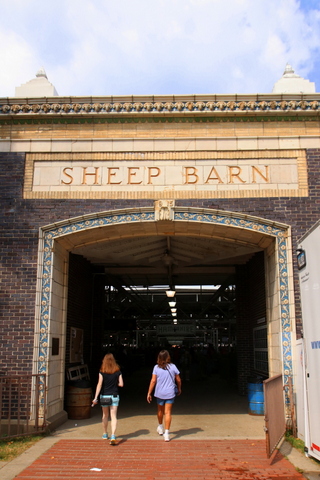
In 1915, the state legislature appropriated $14,000 to build a sheep pavilion. The Sheep Barn opened for the 1917 Iowa State Fair. The building is notable for the detailed terra cotta designs on the east façade, including a row of rams’ heads near the roof.
Sheep Pavilion opened for 1917 fair
During the Golden Age of Agriculture, state funding was available to construct a wide range of livestock barns at the Iowa State Fair. In 1915, the state legislature appropriated $14,000 to build a sheep pavilion. The Sheep Barn opened for the 1917 Iowa State Fair. The building is notable for the detailed terra cotta designs on the east façade, including a row of rams’ heads near the roof.
The legacy lives on
The Iowa State Fairgrounds was listed on the National Register of Historic Places in 1987. It’s a fitting honor for a unique venue filled with many architectural marvels. “The late Bill Wagner, a preservation architect from Iowa, noted that ‘the complex contains a representative collection of almost all architectural styles for most of the past 200 years,’” Landis said.
Historic buildings are just one of the many reasons the Iowa State Fair is the best state fair in the nation, Reynolds said. “I’m extraordinarily proud of this tradition. Remember—nothing compares to our great Iowa State Fair!”
Take a virtual tour
The Iowa State Fair Walking Tour can be found on the Iowa Culture App. Either download the app, or log onto dcaapp.com. Click on the featured tour “Star” button on the right and look for the “Iowa State Fair tour.”
Want more?
Thanks for stopping by. I invite you to read more of my blog posts if you want more more intriguing Iowa stories and history, along with Iowa food, recipes and tips to make you a better communicator. If you like what you see and want to be notified when I post new stories, be sure to click on the “subscribe to blog updates/newsletter” button at the top of this page. Feel free to share this information with friends and colleagues who might be interested, too.
If you’re hungry for more stories of Iowa history, check out my top-selling “Culinary History of Iowa: Sweet Corn, Pork Tenderloins, Maid-Rites and More” book from The History Press, as well as my Calhoun County” book from Arcadia Publishing, which showcases the history of small-town and rural Iowa. Order your signed copies today! Iowa postcards are available in my online store, too.
Let’s stay in touch. I’m at darcy@darcymaulsby.com, and yettergirl@yahoo.com.
P.S. Thanks for joining me. I’m glad you’re here.
@Copyright 2017 Darcy Maulsby & Co.
About me:
Some people know me as Darcy Dougherty Maulsby, while others call me Yettergirl. I grew up on a Century Farm between Lake City and Yetter and am proud to call Calhoun County, Iowa, home. I’m an author, writer, marketer, business owner and entrepreneur who specializes in agriculture. Learn more at www.darcymaulsby.com.

